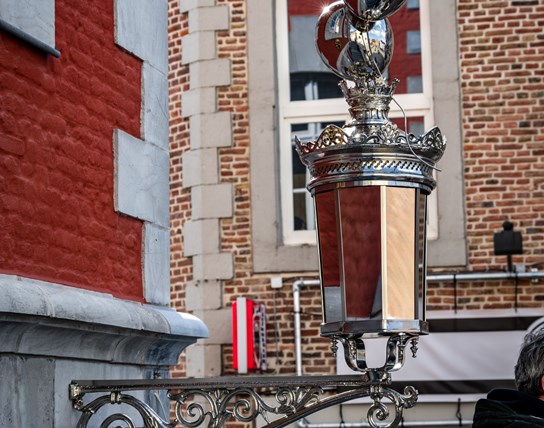Barbara Wyckmans initiated the 9th Month art project. This long-running expo project installs a contemporary art work in Tongeren city centre every two years. Each time, Belgium’s oldest city creates a new modern art route alongside its famous heritage sites, reinforcing its image as a trendsetter.
Luizado
The inspiration for this six-meter high sculpture by artist Nick Ervinck was the statue of the Jupiter in the Gallo-Roman museum
Roman Riots
With Roman Riots, Nadia Naveau brings us a modern interpretation of the Centauromachy, a mythical Greek fight that is often depicted in the art of Classical Antiquity. Only a few fragments of this historical group of statues have been found. The missing parts have been replaced by metal. Take a closer look. You will be surprised by a number of absurd elements: Apollo with a motorbike helmet, a Centaur in a diving helmet, a remarkable Rolls Royce, … even cartoon character Popeye has a place.
Lily Pond
The Lily Pond by Hans Op de Beeck is an impressive ‘living’ sculpture. It is an interpretation of a reflective pool – even though there is no water. The dark surface reflects the sky, the beguine and the surrounding greenery. Reflections of light and the surroundings alternate like waves. This is a wonderful place to meet up, or just to take a rest to enjoy the bronze water lilies that are always in bloom.
To the Point
(Liliane Vertessen – Museumplein) / In one respect, the work ‘To the Point’ refers to Tongeren's stratification. The Roman level is now a few metres underground. The ‘arrow’ symbolically refers to the point from which our history (as well as our future) departs… On the other hand, this work of art also refers to the important role of the Gallo-Roman Museum: ‘To the Point’ as in ‘come to the point’. The artist refers to a museum's function as an institution where residents and visitors receive an explanation of the city's and the region's past in an intelligent and clear manner.
The Third Paradise
Michelangelo Pistoletto
Tongeren works together with the Italian artist Michelangelo Pistoletto, who is an important representative of ‘Arte Povera’, in which the artist uses simple materials. Pistoletto created The Third Paradise, in which people seek a sustainable balance with nature. His philosophy is symbolised by a new infinity sign: two small circles that are attached on opposite sides of a central ring.
Tongeren continues to strive to spread Michelangelo Pistoletto’s philosophy.
Le Prince Evêque
This art project was made by the artistic duo ‘Le Prince Evêque’ but inspired by Pistoletto’s philosophy. It presents three Gallo-Roman burial mounds (tumuli) that mark the landscape in and around Tongeren. The middle hill is larger than the other two. A downward shaft runs through its centre, fitted with a mirror that reflects the sky. The silhouette depicts the upper part of the Third Paradise symbol.
In Memoriam
Renato Nicolodi (°1980) tries to evoke a universal sacredness through his work. His works are monumental beacons for contemporary people living at a time when society is in a state of flux and everything is being questioned. They are visual anchor points that invite the viewer to reflect and meditate.
Traces of histories
Drawings, sculptures, and installations by Belgian artist Wesley Meuris (b. 1977) have a strong architectural, or even scientific, character. Things that might look like structures or devices to present works or other artefacts at first glance are in fact works of art themselves. By bringing these mechanisms and demonstration objects to light, Wesley Meuris points out our way of presenting and looking at things. For instance, by exhibiting empty display cases, pedestals, or architectural situations, reduced to the simplest apparatus, he wants to show us things that usually escape our gaze, but which nevertheless play a primordial role in our daily interpretation of the world that surrounds us. His sculptures and installations are often accompanied by drawings and analytical diagrams that reinforce the functional nature of these subjects.
Shelter
‘Egocentrism, inequality and our socio-economic models drive people apart. We become strangers to each other and our environment. This leads to loneliness, sadness and anxiety. Els Dietvorst makes art out of necessity, out of hope for change. Through her work, she creates meeting places, ways of being together, sharing and acting together.’
For the Plinius Park in Tongeren, Els created the sculpture 'Shelter'. The work connects a number of essential elements present in our city's history, but also relevant in the artistic path Els travels and walks.
Voor de Dag
Drawings, sculptures, and installations by Belgian artist Wesley Meuris (b. 1977) have a strong architectural, or even scientific, character. Things that might look like structures or devices to present works or other artefacts at first glance are in fact works of art themselves. Wesley Meuris’s piece Voor de Dag closely resembles (and certainly doesn’t clash with) the uniqueness and history of the building.
On either side of the building were once two beautifully crafted lanterns that were proof of excellent craftsmanship. However, only one of the lanterns made it through the ravages of time. This lantern was renewed as part of the town hall’s restoration works. It is now located on the left side of the building.
A copy of the existing lantern is located on the right side, thus restoring the previous symmetry. However, the new lantern is made entirely of a reflective material that acts as a mirror.













